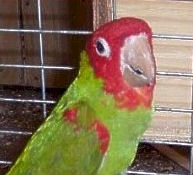
“Lola is such a happy little bird! She is a DNA sexed female Cherry-headed Conure and she eats Zupreem Pellets. She doesn’t talk but is very playful!”..Diane
   The Red-masked Conure or Cherry-headed Conure is an affectionate and playful coompanion bird. When they are hand raised they have no fear of people and will quickly become ‘one of the bunch’. They make a wonderful pet!
Besides being very intelligent and loveable, the Red-masked Conure or Cherry-headed Conure is a real clown and loves to show off. They are easy to tame and are good talkers. They do however have a grating call and can get quite loud. They also love to play and chew, so be sure to provide them with lots of wooden toys to keep them well occupied.
The Red-masked Conure is the bird most often referred to when describing the Cherry Headed Conure, however it is one of four conures that are sometimes called the Cherry-headed Conure. This group of red-headed conures includes the Wagner’s Conure, the Mitred Conure, the Finsch’s Conure, and of course the Red-masked Conure.
This confusion usually happens because these conures can look very similar when they are juveniles. Though generally beyond six months they can be distinguished, It does takes several years for them to get their full coloration, and then they are much easier to identify. The Red-masked Conure is the smallest and is the most colorful of these four red-headed conures.
For more information about the care of Conures see:
Guide to a Happy, Healthy Conure
- Kingdom: Animalia
- Phylum: Chordata
- Class: Aves
- Order: Psittaciformes
- Family: Psittacidae
- Genus: Aratinga
- Species: erythrogenys
Scientific name:
Distribution:
The Red-masked Conure or Cherry-headed Conure is found in the arid zones of western Ecuador and northwestern parts of Peru. They inhabit open forests or the forest edge and are sometimes found near towns.
Description:
This conure has a beautiful green plumage that is paler and more yellowish on the underside. Except for the back half of the cheeks the whole head is red, completely encircling the eyes and often on the throat and neck as well. There is also red on the shoulders, underside of the wings and the thighs. The eye is yellow surrounded by a naked, creamy white eye ring. The beak is horn colored and the legs are gray.
Young Red-masked Conure’s have gray eyes and lack the red on the head.
Size – Weight:
The Red-masked Conure will reach up to 13 inches (33 cm) and weigh 5.8 – 6.5 ozs (164 – 184 g).
Care and feeding:
A roomy cage is required unless the bird is to be let out for extended periods. Many birds can spend most of their time on a play pen or parrot perch. They eat a variety of seeds, nuts, fruits, and commercial pellets, as well as the same nutritional foods humans eat.
See About Conures: Housing and About Conures: Care and Feeding for more information.
Social Behaviors:
These birds make a very warm and friendly pet.
Breeding/Reproduction:
The Red-Masked Conure breeds readily in captivity, though generally in the hotter part of the year. The female will lay between 3 to 4 eggs which will incubate for about 23 to 25 days. The young will fledge at about 6 weeks and be fully weaned by 11 or 12 weeks. The breeding box should be about 10″ (25 cm) by 11″ (28 cm) and 21″ (53 cm) deep, with a 4 1/2″ (11 cm) entrance.
Potential Problems:
As with many Aratinga species, Red-masked Conures or Cherry-headed Conures can be quite noisy.
See About Conures: Potential Problems for more information.
Availability:
This bird is fairly available. Your best bet is to find one at a pet store or reputable breeder.
Activities:
Loves to climb and play. Provide lots of toys.
Featured Image Credit: bluepaints Pixabay
